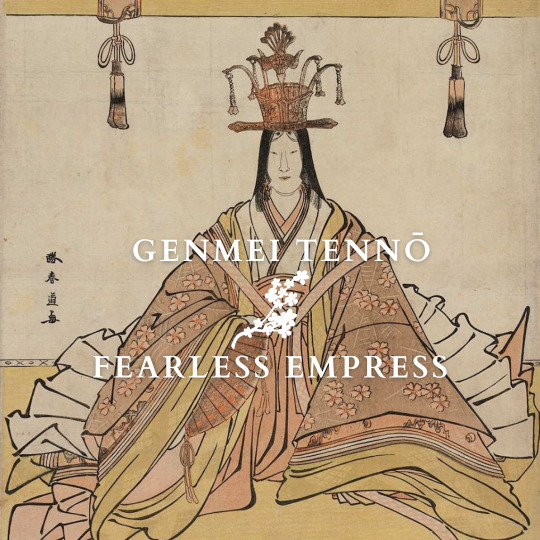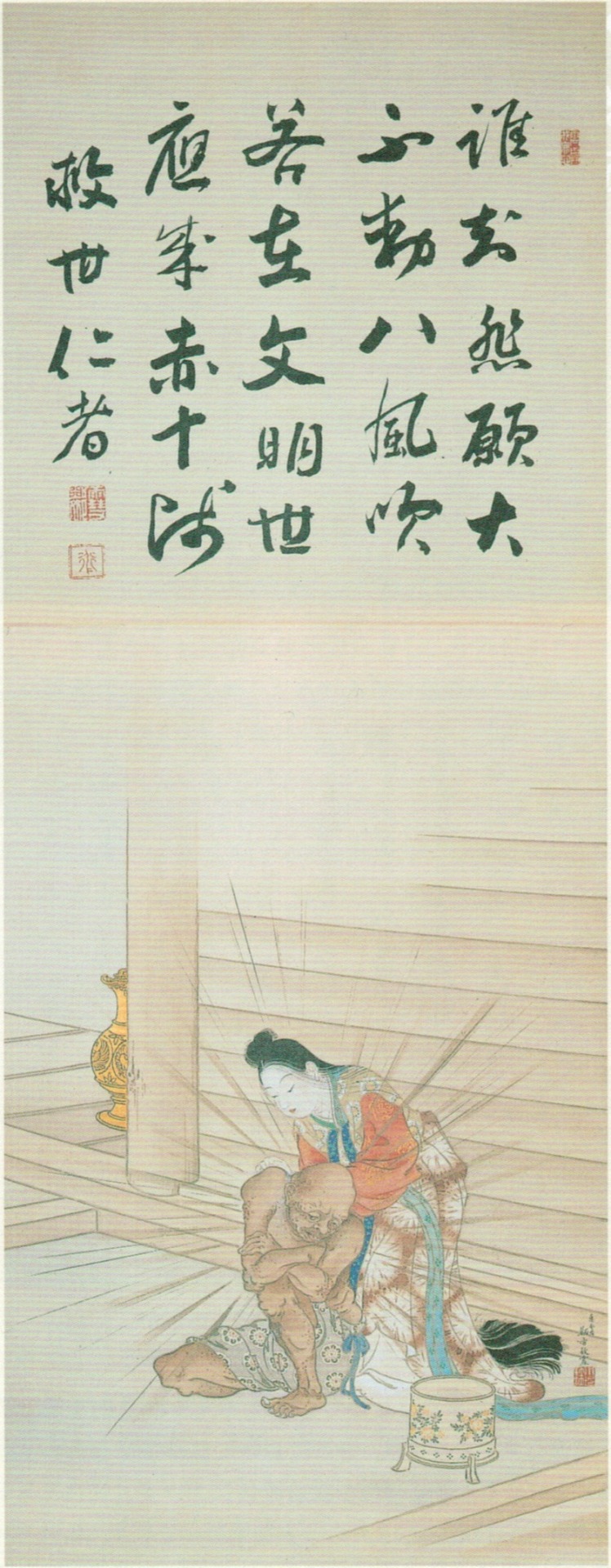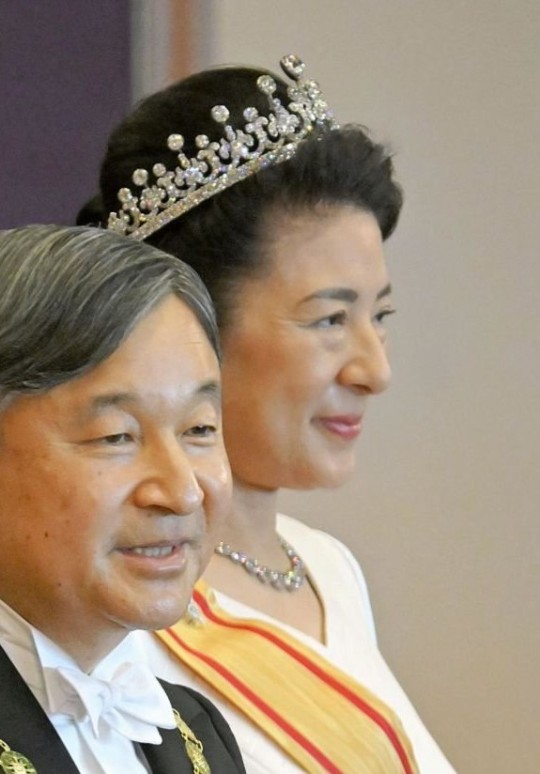#japanese empresses
Explore tagged Tumblr posts
Text

Genmei (661-721) was Japan's fourth empress regnant. She was Empress Jitō's half-sister and her match in terms of ambition and political skills. Her rule was characterized by a development of culture and innovations.
Ruling after her son
Like Jitō (645-703), Genmei was the daughter of Emperor Tenji but was born from a different mother. Jitō was both her half-sister and mother-in-law since Genmei had married the empress’ son, Prince Kusakabe (662-689). She had a son with him, Emperor Monmu (683-707).
Kusakabe died early and never reigned, which led to Jitō's enthronement. The empress was then succeeded by her grandson Monmu. The latter’s reign was short. In his last will, he called for his mother to succeed him in accordance with the “immutable law” of her father Tenji. Genmei accepted.
Steadfast and ambitious
Genmei was made from the same mold as her half-sister. She proved to be a fearless sovereign, undeterred by military crises.
She pursued Jitō's policies, strengthening the central administration and keeping the power in imperial hands. Among her decisions were the proscription of runaway peasants and the restriction of private ownership of mountain and field properties by the nobility and Buddhist temples.
Another of her achievements was transferring the capital at Heijō-kyō (Nara) in 710, turning it into an unprecedented cultural and political center. Her rule saw many innovations. Among them were the first attempt to replace the barter system with the Wadō copper coins, new techniques for making brocade twills and dyeing and the settlement of experimental dairy farmers.
A protector of culture
Genmei sponsored many cultural projects. The first was the Kojiki, written in 712 it told Japan’s history from mythological origins to the current rulers. In its preface, the editor Ō no Yasumaro praised the empress:
“Her Imperial Majesty…illumines the univers…Ruling in the Purple Pavillion, her virtue extends to the limit of the horses’ hoof-prints…It must be saif that her fame is greater than that of Emperor Yü and her virtue surpasses that of Emperor Tang (legendary emperors of China)”.
In 713, she ordered the local governments to collect local legends and oral traditions as well as information about the soil, weather, products and geological and zoological features. Those local gazetteers (Fudoki) were an invaluable source of Japan’s ancient tradition.
Several of Genmei’s poems are included in the Man'yōshū anthology, including a reply by one of the court ladies.
Listen to the sounds of the warriors' elbow-guards;
Our captain must be ranging the shields to drill the troops.
– Genmei Tennō
Reply:
Be not concerned, O my Sovereign;
Am I not here,
I, whom the ancestral gods endowed with life,
Next of kin to yourself
– Minabe-hime
From mother to daughter
Genmei abdicated in 715 and passed the throne to her daughter, empress Genshō (680-748) instead of her sickly grandson prince Obito. This was an unprecedented situation, making the Nara period the pinnacle of female monarchy in Japan.
Genmei would oversee state affairs until she died in 721. Before her death, she shaved her head and became a nun, becoming the first Japanese monarch to take Buddhist vows and establishing a long tradition.
Feel free to check out my Ko-Fi if you like what I do! Your support would be greatly appreciated.
Further reading
Shillony Ben-Ami, Enigma of the Emperors Sacred Subservience in Japanese History
Tsurumi Patricia E., “Japan’s early female emperors”
Aoki Michiko Y., "Jitō Tennō, the female sovereign",in: Mulhern Chieko Irie (ed.), Heroic with grace legendary women of Japan
#history#women in history#women's history#japan#japanese history#empress genmei#japanese empresses#historical figures#historyedit#herstory#nara#japanese art#japanese prints
202 notes
·
View notes
Text

Empress Yamatohime, transl. by Kenneth Rexroth, from Written on The Sky; Poems from the Japanese
#lit#empress yamatohime#poetry#quote#japanese literature#kenneth rexroth#words#typography#dark academia#p
5K notes
·
View notes
Text

Empress Genmei (元明天皇, Genmei-tennō, April 20, 660 – December 29, 721), also known as Empress Genmyō, was the 43rd monarch of Japan, according to the traditional order of succession.[2] Genmei's reign spanned the years 707 through 715.
#Japanese empresses#Japan#Japanese culture#Empress Genmei#Empress Genmyo#Monarchs of Japan#Genmei#Genmei-tenno
0 notes
Text



Japanese Imperial Family - Empress Masako wears the Imperial Chrysanthemum Tiara with diamond drop earrings and a diamond necklace as she attends the State Banquet in their honour at Buckingham Palace in London, England | June 25, 2024
#royaltyedit#royaltygif#royal tiara#theroyalsandi#empress masako#empress masako of japan#imperila chrysanthemun tiara#japan state visit 2024#japanese imperial family#my gif
213 notes
·
View notes
Text

TIARA ALERT: Empress Masako of Japan wore the Imperial Chrysanthemum Tiara for the banquet during the state visit to the United Kingdom at Buckingham Palace on 25 June 2024.
#Tiara Alert#Empress Masako#Japan#Japanese Imperial Family#tiara#diadem#royal jewels#tiaras#diadems#royaltyedit
169 notes
·
View notes
Text


Queen Camilla, The Prince of Wales and Empress Masako of Japan attend the ceremonial welcome during day one of the Emperor and Empress of Japan's State Visit to the United Kingdom, at Horse Guards Parade in London, England -June 25th 2024.
#queen camilla#prince william#prince of wales#british royal family#england#empress masako#japanese imperial family#japan#2024#june 2024#japanese state visit#state visit#state visit 2024#the wales#my edit
65 notes
·
View notes
Text





Morgan Fey ACE ATTORNEY COSPLAY Transformation Video - TheOpalEmpress
#ace attorney cosplay#Morgan fey#Morgan Fey cosplay#ace attorney#the opal empress#逆転裁判#逆転裁判コスプレ#capcom#phoenix wright ace attorney#phoenix wright#kurain village#ace attorney art#ace attorney fanart#綾里キミ子コスプレ#綾里キミ子#コスプレ#kimono#japanese hair#halloween cosplay
38 notes
·
View notes
Text

"Portrait of Empress Kōmyō" (光明皇后像) by Kobori Tomoto (小堀鞆音), 1920's, illustrating the scene in which the Empress (701-760) administers a medicinal bath to a leper (actually a divine bodhisattva in disguise) according to her vow at the temple bathhouse she established.
"Retrato de la emperatriz Kōmyō" (光明皇后像) de Kobori Tomoto (小堀鞆音), años 20, que ilustra la escena en la que la emperatriz (701-760) administra un baño medicinal a un leproso (en realidad un bodhisattva divino disfrazado) según su voto en la casa de baños del templo que ella estableció
Hanging scroll, ink and colors on silk from the collection of Hokkeji Temple (法華寺) in Nara
Image from "Amamonzeki: A Hidden Heritage: Treasures of the Japanese Imperial Convents" published by the Sankei Shimbun, 2009, page 52
#japanese art#arte japonés#小堀鞆音#kobori tomoto#光明皇后#komyo kogo#empress komyo#奈良市#nara#法華寺#hokkeji#crazyfoxarchives
88 notes
·
View notes
Text

“The way the Imperial court broke Empress Masako, a Harvard and Oxford educated economist, lawyer, and diplomat, is a cautionary tale. Successfully marrying into a royal family takes more than just looks and brains, it takes a lot of grit.” - Submitted by Anonymous
62 notes
·
View notes
Text
I'm very much an out of sight, out of mind kind of person so I haven't been that bothered about Kate being gone. It's not personal, I'm just fine not seeing people if I know they're ok. But I am genuinely sad that she isn't there next to Masako. I have wanted them to interact for such a long time.
#british royal family#kate middleton#2024#japanese imperial family#empress masako#last Japan state visit was 26 years ago#I can’t wait 26 years
35 notes
·
View notes
Text

Empress Kōken-Shōtoku (718–770) has long been burdened by an undeserved negative reputation. Far from being a weak woman, she was in fact the last great empress regnant of Japan.
The Crown Princess
Her father was Emperor Shōmu, and her mother, Empress Consort Kōmyō, wielded significant influence. In 727, Kōmyō gave birth to a son, but he tragically died shortly after. In 738, Kōken, then known as Princess Abe, was declared crown princess—a historic first, as no woman before her had been officially named heir apparent, despite Japan’s history of female rulers.
Her early education was overseen by her mother, followed by a renowned scholar who taught her Chinese classics and statecraft. In 749, she ascended the throne after her father’s abdication.
Her First Reign
The Great Buddha Hall at Tōdaiji Temple was completed during her reign. Like her parents, she was a fervent supporter of Buddhism. As a patron of the arts and a sponsor of sutra distribution, she played a key role in establishing Buddhism as a cornerstone of Japanese culture for centuries.
However, Kōken also faced challenges, particularly the growing influence of the powerful Fujiwara clan, to which her mother belonged. After her father’s death in 756, he had designated a successor for Kōken, but the strong-willed empress chose her own candidate. She abdicated in 758 to focus on religious matters.
Machinations and Revolts
Kōken was thus free from the constraints of court ceremonies and quickly became a focal point for opposition to the Fujiwara clan. During this period, she formed a close relationship with the monk Dōkyō, who healed her during an illness in 761.
Legend claims that Kōken once lamented to her attendants that while a male emperor could take multiple consorts, she was expected to remain single. Whether true or not, she was likely aware of the societal constraints imposed on her.
Meanwhile, her successor, Emperor Junnin, sought to wage war against the Korean kingdom of Silla. Kōken opposed him, asserting that matters of such importance—war, rewards for merit, and punishment for wrongdoing—were decisions only she, as a former empress, was qualified to make.
Junnin’s chief minister, Fujiwara no Nakamaro, plotted a revolt against Kōken, but she acted swiftly. Her forces defeated Nakamaro in a decisive battle, leading to his capture and execution. Kōken then deposed Junnin, exiling him and reclaiming the throne in 764 as Empress Shōtoku. By this point, her authority was unchallenged.
Return to Power
During her second reign, Kōken-Shōtoku consolidated her power. She prohibited unauthorized land claims and banned officials from keeping private weapons. She also worked to integrate Buddhist and Shinto beliefs. Her reign saw Japan’s first examples of woodblock printing, which she sponsored in 764.
Kōken-Shōtoku granted significant responsibilities to Dōkyō, though his roles appeared more religious than political. The question of succession remained unresolved. Tensions escalated in 769 when an oracle from the Usa Hachiman Shrine declared that Dōkyō should become emperor. This tentative from someone unrelated to the imperial lineage to usurp the throne caused a scandal. However, sources documenting this event were written later and likely by Kōken-Shōtoku’s detractors.
Kōken-Shōtoku sent the courtier Wake no Kiyomaro to verify the oracle, and he returned with a new prophecy refuting the first. Furious, Dōkyō exiled Kiyomaro, further deepening court divisions. Kōken-Shōtoku withdrew with Dōkyō to Kawachi Province, ruling from there until her return to Nara in 770. She died later that year at age 52.
Following her death, women's roles at court changed and they were bared from ruling. It wasn’t until 1629, with Empress Meishō, and later Empress Go-Sakuramachi (1740–1813), that women once again sat on the throne, though their roles were largely symbolic.
The controversy surrounding Dōkyō tarnished Kōken's reputation. Before World War II, schoolchildren were taught that her so-called "feminine weakness" was why women shouldn’t rule.
Yet Kōken was far from a puppet ruler. She was a decisive leader with a will of her own. As the last great Japanese empress regnant, she deserves to be remembered for her accomplishments.
Enjoyed this post? You can support me on Ko-fi!
Japanese empresses regnant: Suiko, Kōgyōku-Saimei, Jitō, Genmei, Genshō
Further reading
Brown Norton Louise, Block Printing & Book Illustration in Japan
��Kōken, histoire de la dernière grande impératrice japonaise”
Tsurumi Patricia E., “Japan’s early female emperors”
Aoki Michiko Y., “Jitō Tennō, the female sovereign”,in: Mulhern Chieko Irie (ed.), Heroic with grace legendary women of Japan
#Kōken#Shōtoku#empress Kōken#history#women in history#women's history#historyedit#japanese history#japan#asian history#empresses#japanese empresses#queens#powerful women#historical figures
68 notes
·
View notes
Text




Their Majesties The Emperor and Empress of Japan arrived in London this afternoon. Their Majesties will stay in the UK until 28 June.
📷 Embassy of Japan in UK vía twitter
33 notes
·
View notes
Text


Japanese Princess Aiko, the only child of Emperor Naruhito and Empress Masako, turned 23 on Sunday.
This year, the princess graduated from Gakushuin University in Tokyo and began working at the Japanese Red Cross Society in April.
She spends a full and busy life as she works at the organization while performing official duties as an Imperial Family member, according to the Imperial Household Agency.
Source/Read More
#princess aiko#japan#imperial family of Japan#japanese imperial family#empress masako#emperor naruhito#princess toshi
17 notes
·
View notes
Text



Japanese Imperial Family and British Royal Family - Emperor Naruhito and his wife Empress Masako of Japan (R) greets by the Prince of Wales at their hotel, on behalf of the King, before the ceremonial welcome at Horse Guards Parade, for their state visit to the United Kingdom in London, England. | June 25, 2024
#royaltyedit#royaltygif#theroyalsandi#emperor naruhito#empress masako#prince of wales#emperor naruhito of japan#empress masako of japan#prince william#prince william prince of wales#japan state visit 2024#japanese imperial family#british royal family#my gif
157 notes
·
View notes
Text

TIARA ALERT: Empress Masako wore Empress Shōken's Meiji Scroll Tiara at the New Year’s Reception at the Imperial Palace in Tokyo on 1 January 2024.
#Tiara Alert#Empress Masako#Japan#Japanese Imperial Family#tiara#diadem#royal jewels#tiaras#diadems#royaltyedit
114 notes
·
View notes
Text



Queen Camilla, The Prince of Wales and Empress Masako of Japan attend the ceremonial welcome during day one of the Emperor and Empress of Japan's State Visit to the United Kingdom, at Horse Guards Parade in London, England -June 25th 2024.
#queen camilla#prince william#prince of wales#british royal family#england#empress masako#japanese imperial family#japan#2024#june 2024#japanese state visit#state visit#state visit 2024#the wales#my edit
47 notes
·
View notes